 Jim Beloff is a ukulele renaissance man. He is the author of The Ukulele—A Visual History(Backbeat Books) and author, arranger, and publisher of the popular Jumpin’ Jim’s series of ukulele songbooks that have sold over 300,000 copies worldwide. His family company Flea Market Music, also produces the popular Flea and Fluke ukuleles.
Jim Beloff is a ukulele renaissance man. He is the author of The Ukulele—A Visual History(Backbeat Books) and author, arranger, and publisher of the popular Jumpin’ Jim’s series of ukulele songbooks that have sold over 300,000 copies worldwide. His family company Flea Market Music, also produces the popular Flea and Fluke ukuleles.
1. You’ve compiled many popular songbooks. Do you have any suggestions on learning tunes from songbooks and then committing them to memory?
Learning to comfortably perform a song is not unlike telling a story you’ve told many times before. For me, the best way to learn and memorize songs is to first understand their structure. Classic tin-pan alley songs like Five Foot Two and countless others are arranged in an AABA structure. This means that the first, second and last verse all have similar melodies and chords with different lyrics. The bridge or B section (“Now if you run into a five foot two…) employs a different melody and chord combination. Its function is to give the audience something new to listen to after having heard the main theme twice. After this section the final verse feels like coming home to an old friend.
There are many other structures that you’ll encounter as you start learning to play and perform songs. Michael Row The Boat Ashore is one musical section repeated many times with different lyrics. Jingle Bells uses a verse/chorus structure. It starts on the chorus (“Jingle Bells…) and then, following each verse (“Dashing through the snow…” etc.), returns to the chorus. Many pop songs in the 1970s had complex structures. The Doobie Brothers What A Fool Believes is a remarkably sophisticated song that is made up of multiple sections, bridges and choruses.
Once you know the structure of a song, memorizing it is like hanging ornaments on a Christmas tree. The melodies, lyrics and chords all work together to advance the story. In workshops I often teach the Hank Williams song, Hey Good Lookin’ from our Jumpin’ Jim’s Ukulele Country songbook. In that book the song is in the key of C and the structure is AABA. The verse chords are C/D7/G7/C. After the second verse the arrangement calls for a C7 before going into the F chord that kicks off the bridge (“I’ve got a hotrod Ford…”) After playing through the song once, I ask the workshop attendees what the most important chord is in the entire arrangement. The answer I’m looking for is that C7 prior to the F. Even though it’s a very simple chord it plays a huge role in the “storytelling” aspect of the song. If you listen carefully, the C7 acts as a transition or “hinge chord,” essentially saying “hold on to your hats folks…you ain’t heard nothing yet.” Then the F chord that starts the bridge comes in fresh as a daisy and with new information to impart.
A final point is to take time to think about how you start a song and end it. A musical lick (a unique combination of single notes and/or chords) of some kind in the opening helps to get the attention of the listener and set a mood. The ending or coda allows you to finish your story with a flourish. If you can successfully present your song with these concepts in mind your listeners will reward you with their applause.
2. What are some of the playing insights you’ve garnered by working with Lyle Ritz and Herb Ohta?
In 2001 we released the CD A Night Of Ukulele Jazzfeaturing both Lyle and Herb. It was recorded live at McCabe’s Guitar Shop in Santa Monica, CA and included solo sets by Lyle and Herb followed by a set of the two of them together all backed by bassist Richard Simon. The CD is a great introduction to the unique styles of these two ukulele legends. Over the years Lyle has become best known as a tenor uke player who prefers the lower (baritone) DGBE tuning but with a re-entrant D up an octave. On the CD he starts off with his signature tune Lulu’s Back In Town. His first pass through the tune is a series of chords that highlight the melody on top while including the harmony at the same time. During the break he takes an elegant single note solo. On the Jobim tune Triste he again uses chords to reveal most of the melody but does employ some single note passages.
By contrast, Herb typically plays a soprano-sized C-tuned uke but with the lowered G. Herb began using this tuning early in his solo career to allow him 5 additional notes below middle C for his arrangements. Typically, Herb’s style is to perform songs with an emphasis on picking the single notes of the melody and then adding chords as accents. His biggest hit, Song For Anna, is a great example of this combination of single notes and chords.
While I’m a huge fan of both of their approaches, as a player I’ve been especially influenced by Lyle’s style. As someone who shivers when I hear a beautifully placed altered chord, I love hearing and arranging chord solos where the melody and harmony are both communicated via a series of well chosen chords.
I’ve also had the great pleasure and honor of writing lyrics for both Lyle and Herb. As you might expect, their individual writing styles reflect their holistic approach to music and I’ve greatly enjoyed disappearing into both of their melodic and harmonic worlds while working on the words.
3. Do you have any suggestions on how to move from chord to chord more easily?
Over the years I’ve developed a 2 hour beginners workshop that takes new players through songs with two or three chords up to a song like Blue Moon with a dozen or so chords. I start by teaching the C and G7 chords and then having everyone play (and sing) He’s Got The Whole World In His Hands. From there it’s a series of 8-10 songs that sequentially introduce the tremolo strum, the F chord, the two-finger Hawaiian D7 chord (which I often prefer), the waltz and island strums and more challenging chords like the Bb and Fm. Throughout the workshop I emphasize the zen art of moving from chord to chord. Ultimately it is the ease with which someone can move from one chord to the next that will accelerate his or her playing progress.
To that end, I spend a bit of time talking about the “pinky G chord.” Last year, in workshops I gave in Chicago, Milwaukee and Australia, I found that virtually everyone played their G chord with their index, middle and ring fingers. The reason in most cases was to avoid having to use the weakest finger, the pinky. This is fine in and of itself but it’s particularly unhelpful when going from a G chord to a G7. In order to do that all three fingers need to lift and regroup to make the G7. If, on the other hand, the G is made with the middle finger on the 2nd fret of the C string, the ring finger on the second fret of the A string and pinky on the third fret of the E string you need only lift the pinky and place the index finger on the first fret of the E string to make the same transition. (An even easier way to do this is to simply make a G7 when you need a G chord and put your pinky on the third fret of the E string. Then you only have to lift the pinky to get back to the G7.)
One might question how often you need to shift from G to G7 and my answer is to look at a song like Hey Good Lookin‘ that I referred to earlier. The chord that precedes the C7 in that song is C. If you perform Hey Good Lookin’ in the key of G those two chords become G and G7. So do countless other similar tunes when played in G.
The larger idea is to evolve as a player to the point where you choose fingers to make a chord based on how few have to move to get to the next chord. For example, look at how easily you can make a first position E7 coming from a pinky G. Over time you may realize that you’re making your first position C chord with your pinky because it frees up the three other fingers to plop down on a variety of follow-up chords. And, keep in mind that the sooner you’re able to use your pinky the sooner you can start using those beautiful, jazzy and nuanced 4 finger chords that Lyle and Herb use. Happy strummin’!
Tags: 3 Questions Interview, Jim Beloff, Jumpin' Jim




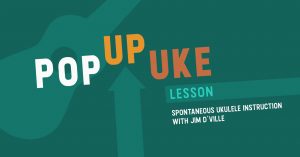
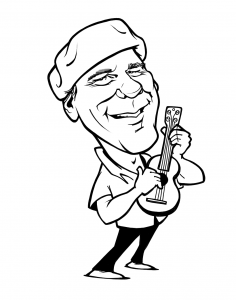

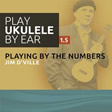

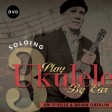






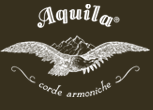
That G to G7 fingering suggestion is an excellent one, it's made me think a lot more about what fingering I choose, something that I have already been giving a lot of thought to of late.